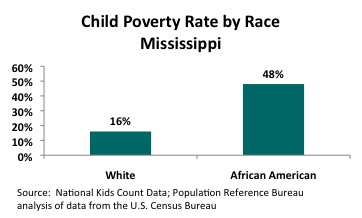Balanced Approach Critical to Long-Term Economic Success of Mississippi
August 18th, 2011
Recently, the 2011 Kids Count Data Book and state profiles of child well being were published by the Annie E. Casey Foundation. Inevitably, stories will be written about Mississippi’s routine ranking of 50th on the Kids Count scale, about some incremental gains and the long road the state needs to travel to make improvements. After reading these stories for a number of years, I’m of the opinion that the ranking is not the most useful indicator in the Kids Count Portfolio for eliciting a call to action or reforms for improvement.
Between the lines of the overall ranking, however, a number of indicators reported by the U.S. Census Bureau and Kids Count show that Mississippi is at a cross road. In the absence of real policy reforms that address the root causes of long-standing poverty, the indicators paint a picture of limited economic progress and potential as we move into the future.
The first indicator includes a demographic profile of Mississippi’s children. For the first time, the 2010 Census reveals that there are now more children of color in Mississippi than white children. Of the children of color, the vast majority are African American – nearly 93 percent.
Yet, African American children as a group start off much further behind their white counterparts. The chart below illustrates the disparities by child poverty rate.
Click to enlarge
Only in Minnesota (MN) and Wisconsin (WI) is the child poverty gap wider between white children and African American children than in Mississippi. The difference – in Mississippi, African American children make up nearly 44 percent of the child population – in MN and WI, African Americans only comprise 7 percent and 11 percent of the child population, respectively.
Children who grow up in poverty are less likely to graduate from high school and go to college. They are also more likely to become incarcerated and to receive public assistance at some point in their lifetime. If nearly a quarter of Mississippi’s future workforce is growing up in poverty, the economic prospects of the state 5, 10, 15 years down the road are essentially capped.
Recent budget cuts have only exacerbated the negative effects of poverty by even further limiting the effectiveness of systems that are in place to create a pathway to opportunity. When thousands of children were no longer able to receive childcare certificates because the money simply was not available to provide children with access to child care, the whole state lost. The children lost access to a learning environment that could be preparing them for kindergarten. Parents who lost their child care found their employment situation threatened. Childcare providers – who happen to be private sector employers – also saw an important revenue stream cut, which also affected the jobs of the teachers in centers across the state.
MEPC has long advocated a balanced approach to budgeting that includes raising revenues. Data and stories like those found in between the lines of news stories and sound bites underscore how important the balanced approach is to the long-term economic success of the state.







